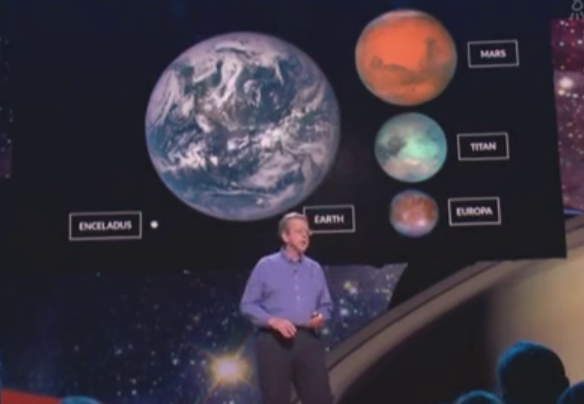Why? We look at the inner planets.
為什么?讓我們看看太陽系的行星:
Venus is way too hot -- it's got no water.
金星太熱——所以沒水。
Mars -- dry and arid. It's got no water.
火星——干旱貧瘠,也不會有水。
And beyond Mars, the water in the solar system is all frozen.
在太陽系中比火星更遠的地方,水全部凍成了固態的冰。
But recent observations have changed all that.
但是最近的觀測改變了這一切。
It's now turning our attention to the right places
現在它把我們的注意力帶到了正確的地方,
for us to take a deeper look and really start to answer our life question.
讓我們去進一步觀察,并且真正開始回答生命的問題。
So when we look out into the solar system, where are the possibilities?
那么,當我們探索太陽系時,生命可能存在于哪里呢?

We're concentrating our attention on four locations.
我們將注意力集中在以下四處:
The planet Mars and then three moons of the outer planets: Titan, Europa and small Enceladus.
火星和更遠的三個衛星:泰坦(土衛六),歐羅巴(木衛二)和小小的恩賽拉多斯(土衛二)。
So what about Mars? Let's go through the evidence.
火星到底是什么情況呢?讓我們看看證據。
Well, Mars we thought was initially moon-like: full of craters, arid and a dead world.
起初我們以為火星像月亮一樣:布滿隕石坑,荒涼,沒有生命。
And so about 15 years ago, we started a series of missions to go to Mars
大約在15年前,我們開始了一系列登陸火星的任務,
and see if water existed on Mars in its past that changed its geology.
去查看那里過去是否有水存在過,還因此改變了它的地質。
We ought to be able to notice that.
我們應該可以觀察得到。
And indeed we started to be surprised right away.
而實際上,我們一開始就很驚訝。
Our higher resolution images show deltas and river valleys and gulleys that were there in the past.
高清圖片顯示,那里有三角洲,河谷和溝渠,它們過去都曾存在過。











